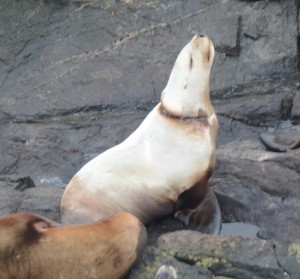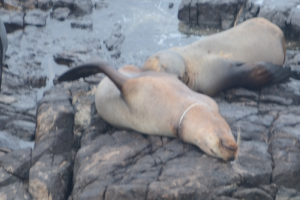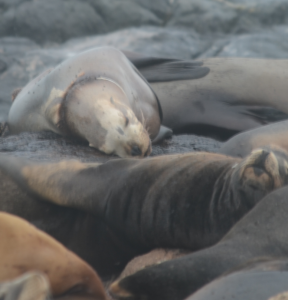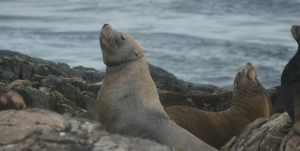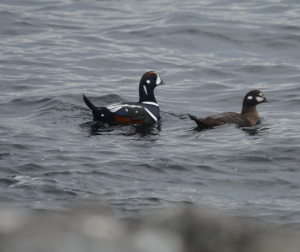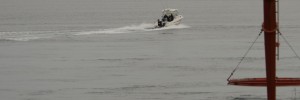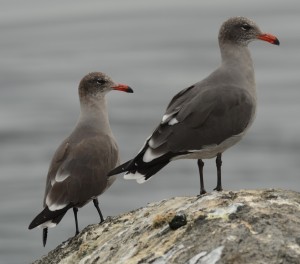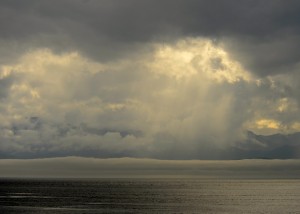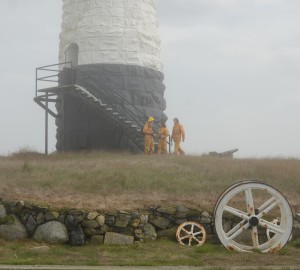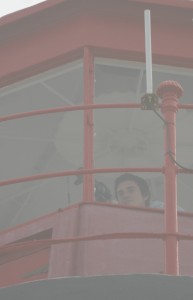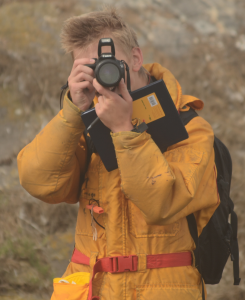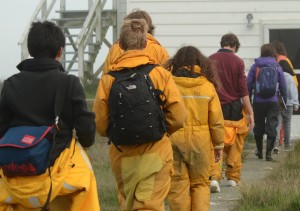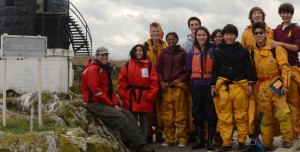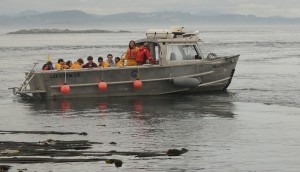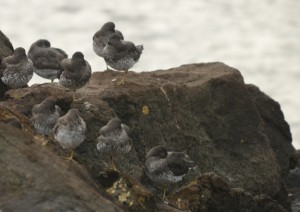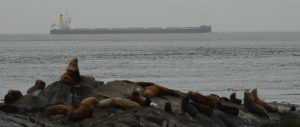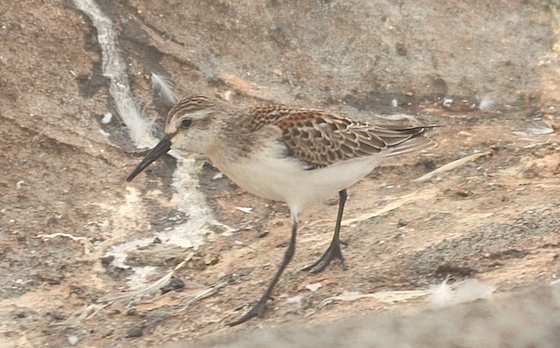Glaucous –winged gulls: 285
Chicks: 130 to 150
Californian Sea lions: 120
Northern Sea lions: 70
Harbour Seals: 50+young ones
Pelagic Cormorant: 3
Oystercatchers: 4
Pigeons-Guillemot: 60
Western Sandpipers: 60to70
Whimbrel: 1
Eagle: 1
Geese: 5
Elephant Seal:0 But Courtney from Second Nature saw 1 small one on middle island
Tag Archives: western sandpiper
Gale warning forecast
We began the day with 32 knots and the wind never stopped rising to 40.7 knots around 8:00PM. What a pretty windy month!
All the birds were in the sheltered side away from the wind so it was easy to spot them. Before dusk we saw 10 Turnstones, 2 Western Sandpipers and 3or 4 Dunlins. They were not around a few days before. Exciting!
I even found a ladybug, a small one in the house. Another new species on this small rock
No whale watchers today …Thanks to the wind.
Birdy stories
On Sunday, which was a sunny but windy day, we found one dead chick, the first one and beyond the student house on the rocks we discovered some newcomers, two beautiful little birds. By deduction and with the pictures sent to Garry, we came to the conclusion that they were 2 Western Sandpipers. A change from gulls!
On the 13th when we went to clean the solar panels we discovered the fresh, bloody, half eaten body of a pigeon – guillemot. We think that it was a Sea otter’s job because of the hidden place where we found it. Busy night!
Whistling House
There was a big blow last night and I learned that this house can whistle; with three distinct tones, synchronously, very musical. This morning there was a swell from the southeaster and an even bigger groundswell coming in from open sea to the west. Add the tidal race to the mix and you can imagine that the wave patterns created were mesmerizing.
It seemed like the day was in recovery from the storm, with gentle winds from the north-northeast, light rain and overcast. The pattern of barometric pressure change was not so reassuring, falling since noon it is now back below 998 hPa. That is where it was for last night’s big blow. It looks like the forecast is for more of the same.
There were six whale-watching boats observed in the Ecological Reserve today; five Canadian and the almost daily visitor from Port Angeles, called Island Explorer. The big draw, other than Race Rocks itself, were abundant Humpback Whales in the area. It certainly wasn’t the weather. At least two of the Humpback Whales were in the Ecological Reserve .
There were four Elephant Seals on the marine railway today, Gat (#5850-6967) , Flake and two larger animals. They ‘played’ together and then slept together for most of the day. More sealions than have hauled out since about a week ago, were also sleeping soundly throughout the day today, perhaps recovering from last night.
The three entangled Stellers sealions that are proposed candidates for disentanglement were all attending, two of them hauling out close to the living-room window of the science house.
When I was doing the seawater sample I noticed a couple of Harlequin Ducks foraging on the north side of the island. I would like to see them on the underwater camera.
More shorebirds were observed foraging on the abandoned sealion haul-out today; Dunlin, Western Sandpipers and Sanderlings were foraging with the Black Turnstones. The smaller birds were kneading the substrate with their feet and probing. That area is completely covered in a mat of sealion hair from their moult.
Even though it was a dark and gloomy day, the solar panels managed to keep up with operational, electrical use. The generator is just cooling now after topping up the batteries for the night.
Thanksgiving Edition (No Turkeys Here.)
The day started with a hazy, overcast sky and an ocean swell rolling in from the open Pacific. Although visibility was 10 to 15 nautical miles, the marine air gave everything a soft, muted look and both Port Angeles and Victoria looked further away than they actually are. In the morning, winds were light to gentle breezes starting in the southwest and swinging over to southeast. In the afternoon it shifted to north-northeast and became noticeably colder and wetter.
The ocean swell became dramatic by mid-afternoon, exploding over north rock and making a rolling break into the jetty bay, surging right over the jetty. Although the barometer was higher today than it has been all week, it is now slowly dropping and Monday ‘s forecast is for more clouds, wind and rain. Hmmm sounds like October.
Whale watching activity was fairly brisk today with seven boats in the Ecological Reserve. Everyone was fairly well behaved. Seaking Adventures was certainly giving a lot of throttle in the Reserve, crossing from Great Race over to North Rock but that may have been because he was bucking the tide. There were also a couple of sports-fishing boats passing through the Reserve in a hurry, Foghorn Charters was one of those two.
A large Humpback Whale passed through the Reserve westbound, late afternoon, there were no whale watching boats around.
A lot more gulls arrived with the cool wet weather and are roosting just about everywhere on Great Race now. I am curious what the numbers will be for this week’s census on Wednesday.
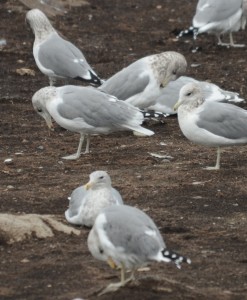 California Gulls resting and preening on Great Race.[/caption]
California Gulls resting and preening on Great Race.[/caption]
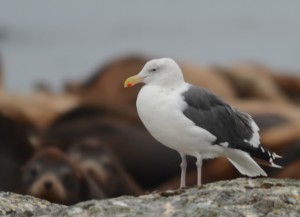
Western Gulls are a little north of their usual range here and hard to distinguish from Glaucous-winged X Western Gull hybrids.
With the influx of California Gulls it is going to be tricky distinguishing and counting all the large gulls. A gull that is easy to distinguish and also a favorite of mine, is the Heerman’s Gull.
Another avian visitor spotted today was the small to medium sized sandpiper pictured below, I think it is a Western Sandpiper but would like confirmation.
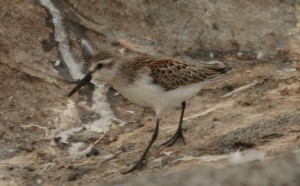
There were two young Elephant Seals on Great Race today and one of them was “tagged as a weiner in 2012” at Ano Nuevo Island in California “and hasn’t been seen since, so this is an important data point” according to Dr. Patrick Robinson, Año Nuevo Island Reserve Director.
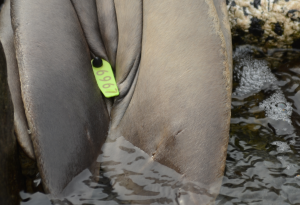
The second Elephant Seal was sleeping on the marine railway in the morning.
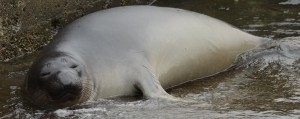
Race Rocks has become Canada’s main Elephant Seal colony. It is important as a fall haul-out location for sub-adults, as well as a winter birthing and mating site and spring moulting site.
Race Rocks is an ecological treasure located at a key location next to busy shipping lanes and popular sport-fishing grounds. I am thankful to those who had the vision to protect this amazing area and thankful to be able to experience it.
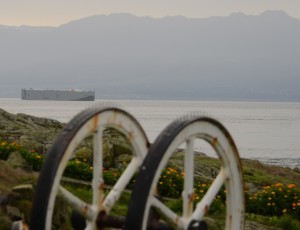
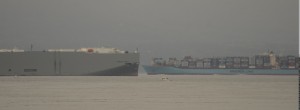
Real Rain
There was measurable rain last night and this morning for the first time in a long time, followed by fairly thick fog. Eventually the fog burned off and the northeast wind chased it out of the Strait. Although it is now blue sky above, it seems to be the donut hole with clouds all around, so expect more showers and outflow winds. The barometer started climbing out of the hole early this morning and kept climbing most of the day, until leveling off late afternoon. On the satellite, it looks like the first pineapple express of the season and we are in the lee of the Olympic Mountains.
There was only one whale watching boat today ‘Gold Wing’, one recreational boat and a couple of commercial charter vessels.
The second of three first year Marine Science classes came for a field trip today. Their quest was similar to yesterday’s class; to make first-hand observations and enter their notes and drawings into their field journals and to add to their species lists. I added consumption of warm fruit crumble, with very Canadian maple syrup to their to do list and the students seemed to enjoy the whole process.
The California Sea Lions seem to be disturbed by the rain and spent the night making a lot of noise. In the morning most of them moved into the water when the rain started again. Could it be that there hasn’t been much rain where they have been? So far we have brands from the Channel Islands, Rogue Reef in southern Oregon and the Columbia River in northern Oregon.
We had some new arrivals today in the form of a flock of very tired Surfbirds. They slept most of the day. Their breeding grounds are in the mountains of the Yukon and in Alaska and they winter here on the coast.
There were also a couple of Western Sandpipers flitting about today. They breed in western Alaska and are heading south, just passing through here. If they are looking for biofilm, Race Rocks is covered in it, even though with its’ high current and rocky substrate, it is the opposite of a mudflat, it has such a massive concentration of life that there is food for eveyone. I saw more Black Oystercatchers today than I have in a couple of weeks. They are one of my favourite birds.
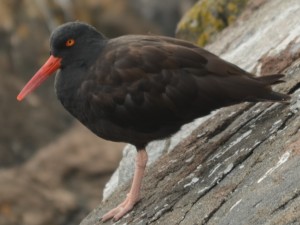
Black Oystercatchers are very jazzy birds. They have the most spartan nests imaginable. The adult pairs are quite site fidel.
I am preparing to attend an international workshop on ocean literacy, followed by the European Marine Science Educator’s Conference. Also trying to trouble-shoot the Davis wind direction data, which is reading greater than 360o. All the normal, potential problems seem fine, so it is still a mystery. Regular tasks like making power, making water, testing the seawater, taking photos of branded animals and generally fighting entropy, continue. Here is another photo for Garry of sea lions in the foreground and shipping in the not too distant background.
last day
Clear skies. Strong NE winds. Cold
Despite the winter weather, it is still a busy place out here in the reserve. The female elephant seals are hauled out on Middle Rock. The male Elephant seal is next to the Science House. There were lot’s of Oyster catchers, and way more Cormorants then I was expecting. There are also still quite a few Sea lions (~470) in the reserve; mostly on the South side of Great Race and South Rocks. I finally got a decent picture of a Savannah Sparrow today; and the Sandpiper stopped long enough to get a good photo so I could finally ID it.
Diversity of Bird Life
‘The diversity of bird life has increased greatly with the improving weather this week. Rock sandpipers, Western sandpipers, Red Knots, and Greater Yellowlegs have all been seen in the intertidal zone. Yesterday evening a juvenile brown pelican spent a number of hours on Great Race before heading towards Port Angeles just after sunset. Today around noon a peregrine falcon zipped by Great Race and scared most of the small bird species away for the day. The Black Oystercatchers are becoming very territorial with one another, and the nest above the cove on the E side of Great Race now has 2 eggs.’, ‘Ryan’, ’17:42:48 ,
Mammal census:
‘Elephant Seal’, 8, ‘8 females remain on Middle Rocks, still in various stages of their moults. The tagged female X201/X202 recently left Great Race Island after completing her moult, but was photographed yesterday on Middle Rocks with the other females. This year is a pattern reversal compared to last year when it was the sub-adult male -Misery) who completed his moult on Great Race and few if any female elephant seals were seen here during this time.’, ‘Ryan’, ’17:45:02 ,
Calidris mauri: Western sandpiper–The Race Rocks Taxonomy
This shorebird breeds in Western Alaska but is very abundant in migration all over North America.
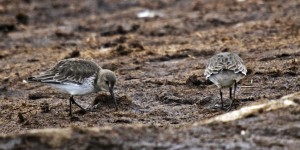
Ryan Murphy took this first picture of the western sandpiper, Calidris mauri in late October, 2009 . The dark legs distinguish it from the Least Sandpiper.
| Domain | Eukarya |
| Kingdom | Animalia |
| Phylum | Chordata |
| Subphylum | Vertebrata |
| Class | Aves |
| Order | Charadriiformes |
| Family | Scolopacidae |
| Genus | Calidris |
| Species | mauri |
| Common Name: | Western Sandpiper |
See other posts tagged Western Sandpiper
and Image File |
 The Race Rocks taxonomy is a collaborative venture originally started with the Biology and Environmental Systems students of Lester Pearson College UWC. It now also has contributions added by Faculty, Staff, Volunteers and Observers on the remote control webcams. The Race Rocks taxonomy is a collaborative venture originally started with the Biology and Environmental Systems students of Lester Pearson College UWC. It now also has contributions added by Faculty, Staff, Volunteers and Observers on the remote control webcams. |

